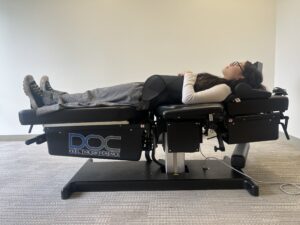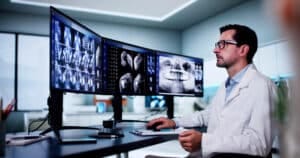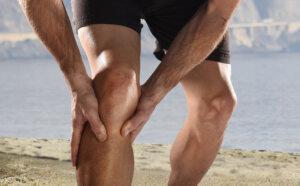Injections to Kick-Start Tissue Repair
The human body is held together by a network of connective tissues that are highly vulnerable to injury – through exercise, accidents and even the normal lifting, pulling and pushing of daily life.
Few of us, for example, get through life without spraining an ankle. And as many sadly know, once an ankle is badly sprained, it may be sprained again and again. That often happens as well with other body parts: shoulders, wrists, neck, back, jaw, feet, even fingers and toes, all of which are subject to arthritic changes after an injury.
The risk of reinjury rises when the ligaments that hold bone to bone, or tendons that connect bone to muscle, fail to heal completely. And such failure is apparently very common. Over time, and with multiple injuries, this incomplete healing can result in lax connective tissues that cannot fully support a joint.
Dr. K. Dean Reeves, clinical associate professor of physical medicine and rehabilitation at the University of Kansas Medical Center, likens the damage to a partly shredded rope that lacks the strength of an intact one, and to stretched putty that will not return to its former length. Dr. Reeves is one of several hundred physicians and osteopaths who specialize in a therapeutic technique called prolotherapy, an alternative medicine method to promote connective tissue repair even years after the damage occurred.
The technique received an endorsement of sorts from the Mayo Clinic. In its April 2005 health letter, the clinic stated that when a chronic ligament or tendon pain fails to respond to more conservative treatments like physical therapy and prescribed exercises, “prolotherapy may be helpful.” And when surgery is the only remaining option to relieve chronic pain, prolotherapy is a much less invasive and expensive technique that may be worth a try – if you can find an experienced and skilled practitioner.
What is Prolotherapy?
Prolotherapy involves a series of injections designed to produce inflammation in the injured tissue. To appreciate the value of such a seemingly counterproductive measure, you need to know something about connective tissue and how the body normally repairs it.
When tissues are injured, inflammation is a common natural response. It stimulates substances carried in blood that produce growth factors in the injured area to promote healing. Ligaments, tendons, and cartilage have very poor blood supplies, which can result in incomplete healing.
The healing process can also be impeded when injuries are treated with anti-inflammatory medications like ibuprofen or Naprosyn, or prescribed nonsteroidal anti-inflammatory drugs (NSAIDs) to relieve pain and swelling.
Unlike injections of corticosteroids, which also suppress inflammation and provide only temporary relief for a chronic condition, prolotherapy injections given over the course of several months are meant to provide a permanent benefit. In effect, prolotherapy tricks the body into initiating a healing response.
The technique reactivates the healing process by injecting a mildly irritating substance – commonly a somewhat concentrated sugar solution along with the painkiller lidocaine – into the injured area to stimulate a temporary low-grade inflammation. In some cases, growth factors themselves may be injected.
With growth factors in place at the site of inflammation, new tissue is said to be produced that strengthens lax or unstable ligaments and tendons. The technique may even support damaged or degenerated cartilage, which normally does not repair itself, by strengthening the fibrous connective tissues that stabilize the area.
Practitioners cite experiments in laboratory animals that demonstrated tissue growth in ligaments and tendons stimulated by prolotherapy injections. Two animals studies also showed healing of cartilage defects.
Prolotherapy cannot correct mechanical problems like spinal stenosis, in which two bones pinch a nerve, nor does it reverse arthritic changes. But it may reduce or even eliminate the discomfort associated with arthritis by tightening the connective tissues that support an arthritic joint.
A leader in the field, Dr. Donna Alderman, an osteopathic physician who is the medical director of the Hemwall Family Medical Centers in California, published two long articles on prolotherapy this year in the magazine Practical Pain Management. She wrote that “prolotherapy has been used in the United States for musculoskeletal pain since the 1930s,” that it has been endorsed by former Surgeon General C. Everett Koop, and that it is increasingly being used to treat injuries in professional athletes.
Prolotherapy is also now the subject of a controlled clinical trial sponsored by the National Center for Complementary and Alternative Medicine, part of the National Institutes of Health.
Since prolotherapy is a nonsurgical technique, patients who are now facing surgery because all else has failed might consider trying it before having an operation. Unlike many drugs and surgery, prolotherapy has minimal side effects when performed by an experienced practitioner who uses sterile techniques. Patients may experience bruising and a temporary increase in pain in the injected area because of the induced inflammation. Rare risks include infection, headache, nerve irritation or allergic reaction.
Does Prolotherapy Help?
There have been dozens of studies supporting the benefits of prolotherapy for people with chronic pain as well as those with sports injuries. Among scientifically designed controlled studies, most showed a significant improvement in the patients’ level of pain and ability to move the painful joint.
According to Dr. Alderman, in a study of people with chronic low back pain resulting from injured ligaments in the sacroiliac joint, biopsies done three months after treatment showed a 60 percent increase in the diameter of connective tissue. The patients reported a decrease in pain and an increased range of motion.
In studies of knee injuries, patients with ligament laxity and instability experienced a tightening of those ligaments, including the often disabling anterior cruciate ligament in the center of the knee, Dr. Reeves showed in a double-blind study. Other studies showed a significant improvement in the symptoms of arthritis in the knee one to three years after prolotherapy injections.
Dr. Alderman cautions that prolotherapy is appropriate only for patients with musculoskeletal pain who do not have underlying conditions that would interfere with healing and who are willing to receive painful injections in an effort to recover.
A state-by-state listing of prolotherapy practitioners can be found at www.getprolo.com. Beware of practitioners who make rash promises, fail to take a full medical history and to tell you about the technique and its side effects, or who work in a disorderly or unclean facility.
Written By Jane E. Brody
To get to the root cause of pain and discomfort, schedule an initial consultation, including a comprehensive evaluation and first treatment.



